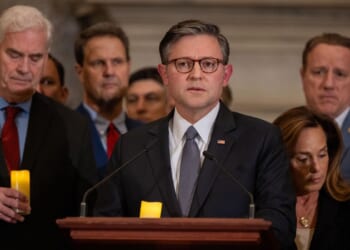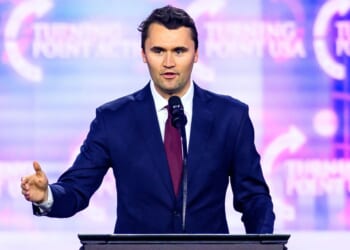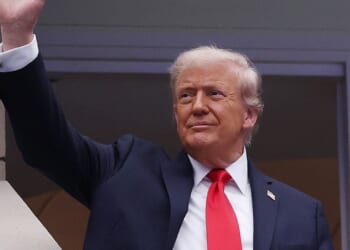It’s 4,350 miles (7,000 kilometers) from Moscow to Anchorage, almost a straight shot over the North Pole via great circle navigation. And it’s not quite 3,400 miles (5,435 km), again via great circle nav, from Washington, D.C. to what some locals call “Anchortown.”
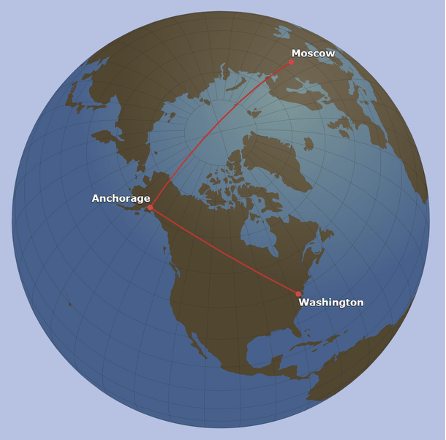
Great circle routes to ANC. Courtesy GreatCircleMap.com.
I mention this point of cartography because today I’ll discuss the upcoming summit meeting in Alaska between U.S. President Trump and Russian President Putin. Perhaps it’s in Anchorage, or maybe another venue; we don’t know yet.
The news hype is that Trump and Putin will work out the bones of a “deal” to end the conflict in Ukraine. Hmm… We’ll see.
And along those hopeful lines, it’s worth pondering what a U.S.-Russia rapprochement might mean to the price of gold, oil, and much else in the global marketplace. Imagine the complexities of lifting sanctions and opening up more trade with Russia. There’s money to be made, for sure.
But for now, let’s discuss Alaska. Let’s ponder Trump and Putin, big-time geopolitics, averting nuclear war, and some fascinating history. We’ll begin 90 years ago in 1935, with a quick note about a long-deceased Army officer, General William “Billy” Mitchell (1879 – 1936), widely credited as the father of American air power. Then we’ll get to what to expect as things unfold between the U.S. and Russia.
A Man with Excellent Eyesight
In 1935, in his last public appearance before he died, Mitchell testified before Congress. His focus was on the importance of air power in modern warfare. He advocated for a strong air force (which was, back then, an arm of the Army) and criticized the U.S. military’s over-reliance on traditional naval and ground forces, to the detriment of aviation.
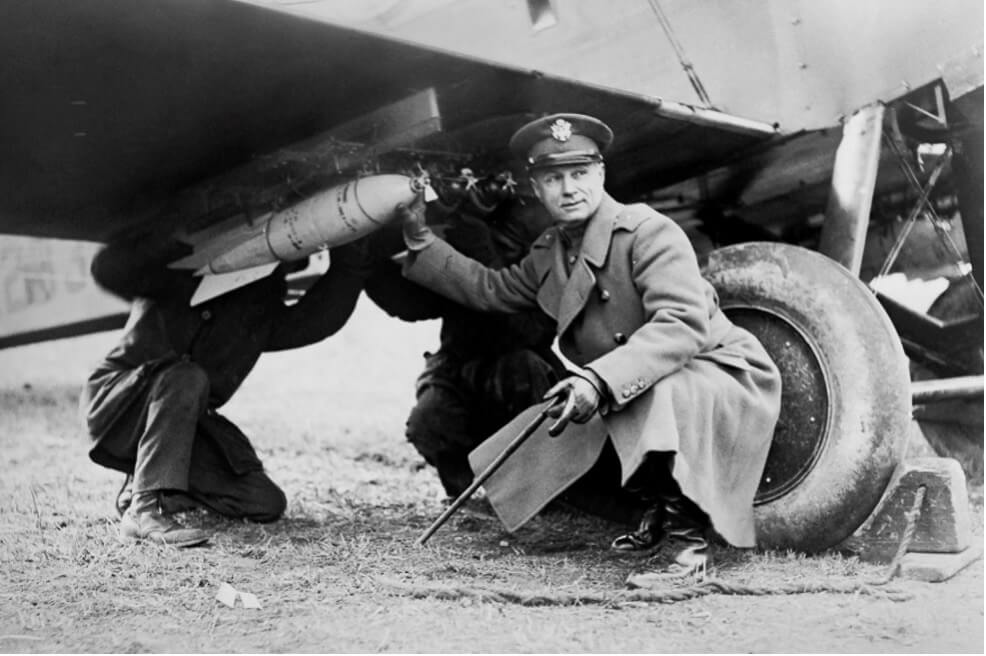
Gen. Billy Mitchell, air power visionary. Courtesy Museum of U.S. Air Force.
At the time, the U.S. was in the grips of the Great Depression. Millions were unemployed. All across the country, vast swaths of industry were idle. The national economy was in shambles. The world trading system was broken. And many Members of Congress had priorities other than spending funds on new and experimental military aircraft.
Still, Mitchell had friends in high places, plus far-thinking ideas about key military issues and aviation developments. And while he was on the public record, teaching a master class on aviation, at one point he reminisced about his time as a young Army officer when he was assigned to string a telegraph line across the wilds of Alaska. In this vein, Mitchell pleaded with Congress to recognize the importance of America’s northern territory (i.e., Alaska didn’t become a state until 1959):
“I believe that in the future,” said Mitchell, “whoever holds Alaska will hold the world. I think it is the most important strategic place in the world.”
Mitchell must have had excellent eyesight because he saw something in Alaska that few others in his day visualized. In an era when even the best airplanes could fly perhaps 1,000 miles at a stretch, Mitchell foresaw faraway Alaska as not just a site for a distant base or two, but as a pivot point from which to project American power across intercontinental distances, into both Europe and Asia.
Sad to say, Congress didn’t act on Mitchell’s advice about Alaska. Not back then, and the place remained an American geographic backwater, even during World War II. Even postwar, as the Lower 48 states boomed, things developed slowly up North. It would be many decades post-Mitchell before the strategic importance of Alaska began to sink into the heads of American policymakers. And it’s fair to say that even today, the criticality of Alaska to America is poorly understood by many of our nation’s policymakers.
But now, this week we’ll have Trump and Putin meeting in the 49th state, an event that may deliver a fully geostrategic outcome, if not at least offer a few teachable moments.
The Hasty Summit
Ask anyone who knows anything about top-line, bigshot summit meetings, certainly between the U.S. and Russia, or pre-1991 with the Soviet Union. These events can be hasty, thrown-together things, or they can be well-planned and carefully scripted. Done right, a summit can become a historic capstone, an event that reflects the beneficial outcome of deep planning, staffing, and back-door negotiation.
That is, a good summit meeting can advance America’s true national interests. While a quickie can devolve into a slapdash photo op that results in little more than a few days of meaningless, forgettable headlines.
Apparently, the Trump administration has wanted something like this summit for many months and summarily announced it with typical White House fanfare. Frankly, though, as an outsider looking in, this Trump-Putin summit appears to be a hastily contrived event. I won’t call it a stunt, but it’s difficult to see where it’s all headed, certainly on the Ukraine issue.
For example, regarding Ukraine, what has Team Trump accomplished in the way of back-office staff work? Have American diplomats, military experts and other subject matter experts met with Russian counterparts to hash out details of a workable agreement? If any of this has occurred, it’s been kept under wraps. But okay, we’ll see.
Meanwhile, it’s worth pointing out that Russia’s government has never deviated from its long-term demands and geopolitical goals vis a vis Ukraine: Russia keeps Crimea and holds the annexed eastern portions of Ukraine; Ukraine remains forever out of NATO; Ukraine must demilitarize to a relatively low level, not capable of threatening Russia; and Ukraine must “de-N@zify” in terms of its political philosophy.
On Ukraine’s part, that nation’s official, public rejoinder to Russia’s set of demands has been consistent: no, no, no, no and no. And from what we’ve seen out of Kiev in the past few days, whatever Trump and Putin decide in Alaska, the answer will still ne “no.”
All that, and Ukrainian reps are not expected even to be in Alaska, so it’ll be just Trump and Putin (plus translators and close staff, of course), talking things over. Plus, no one from the European Union, or any Western European nation and/or non-U.S. NATO will be there either.
Again, wait and see. We’ll have answers on much of this in just a few days, but in many ways the setup indicates one particular outcome: in essence, the U.S. will accede to most Russian demands and pass the baton to Ukraine to accept that outcome.
If Ukraine rejects this particular Alaska denouement, a post-summit Trump will finally be in a position to wash his hands like Pontius Pilate, and the U.S. will back away. I suspect that deep down, that’s exactly what Trump wants, and his naysayers and critics can go pound sand.
Of course, Ukraine can reject the summit outcome and continue its fight against Russia but without another dollar of American assistance. And Trump will shut off of all U.S. hardware, intel, weapons, communications and whatever else has been flowing into the war effort.
Meanwhile, if Western European governments wish to continue helping with the anti-Russia war effort, that’s their choice. Good luck, people.
Ugh, right? But then again, there’s more going on in this Alaska summit than just Trump and Putin drawing lines on the map of Ukraine. Because recall how, per Billy Mitchell, Alaska is “the most important strategic place in the world.”
Historic Russian America, aka Alaska
Just the fact of Russia’s President Putin traveling to America’s state of Alaska is important, indeed strategic if not geostrategic. Because this will be one of Putin’s few trips to a Western nation in many recent years.
That is, Putin’s travels have been truncated by so-called “arrest warrants” against him, issued by the International Criminal Court (ICC), although that organization is about as fake a paper tiger as one can find. Still, out of an abundance of caution, and a desire not to put host countries in a legal predicament, Putin has avoided many overseas trips.
And yet… Here. He. Is. Putin is about to visit Alaska and meet with the U.S. President, no less. But also, and no doubt in the mind of Putin and many Russians back at home, this is also a sort of homecoming to what many Russians call “Historic Russian America.”
There’s much history here; the short version is that for well over a century and a half, until 1867, what we call Alaska was part of the Russian Empire. It’s a story of continental-scale expansion and trade from the Russian side.
But even for Russia in its Imperial days, Alaska was a stretch. For example, in 1809 Russia’s then-Tsar, Alexander I mentioned to future President John Quincy Adams that Russia’s vast size was “one of its greatest evils.” Indeed, said the Tsar, “It is difficult to hold together so great a body as this empire.”
There’s plenty more, but mostly unknown history about Russia, Alaska and the U.S. throughout the early 19th Century; and it’s accurate to say that relations were pretty good. Indeed, the U.S. supported Russia during the Crimean War in 1854-56. And in return, Russia sent naval ships to assist the North during the Civil War, in the form of a heavily armed presence in both New York and San Francisco harbors in 1863-64. One key outcome was that Russian combat vessels helped convince Britain not to enter the war on the side of the South.
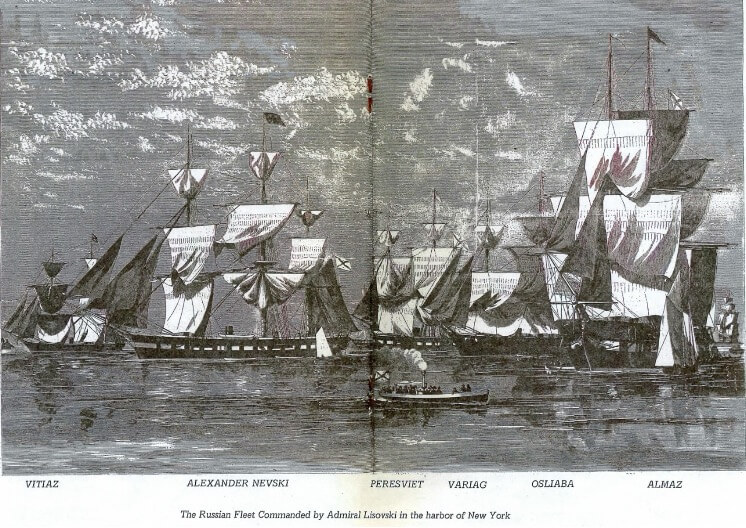
Russian fleet in New York Harbor, 1863. Courtesy U.S. Navy History & Heritage Command.
Then postwar came the Alaska purchase in 1867; again, a story with deep and colorful history, but not here just now. [Although if you are interested, I wrote an article about it for The Daily Reckoning, way back in June 2007. It has aged well, if I say so myself.]
The “Other Matters” on the Table
From current Russian media, it appears that just the idea of Putin visiting Alaska warms many hearts, from St. Petersburg to Vladivostok. And this offers Trump another opening to deal with Russia, at levels over and above the Ukraine mess. Because – and not to be callous – certain other matters dwarf the Ukraine military operation, and it’s time to begin putting out growing fires.
That is, the U.S. and Russia have many critical issues dividing them, particularly with respect to their mutual status as nuclear-armed superpowers. Think in terms of nuclear weapons and delivery systems; or escalations to war; or which side can achieve what’s called “escalation dominance” during tense times, as the proverbial wheels fall off the truck.
Sure, Trump can brag to Putin about American submarines, but so can Putin brag about Russia’s submarine fleet. Same thing with ground forces, bombers, missiles (to include hypersonic missiles), space control, and a long list of other military tech.
In Alaska, Putin has a chance to sit down with Trump and tell him, face to face, what Trump may not know from his U.S. briefings. And really, based on some of the things Trump has said publicly, he’s getting bad intel from the briefers.
The bottom line here is that the U.S. and Russia must get relations back to some semblance of understanding and respect, superpower-to-superpower.
And it’s critical for Trump and Putin somehow to begin a process to undo the “Russia-Russia-Russia” damage of the past decade since Hillary & Friends just plain made stuff up about Trump and Russia. (Ask Tulsi Gabbard, the current Director of National Intelligence). And even before Hillary, we have long-term screwups in U.S.-Russia relations that were the hallmark of the Obama, GWBush, and Clinton administrations.
In other words, in Alaska this week, Trump and Putin have an opportunity to walk backwards through the toxic landscape that has unfolded between the U.S. and Russia since the end of the Cold War in 1991. And if the two leaders can take even a few basic steps toward such a new beginning, then Alaska will be – and in a way that not even Billy Mitchell foresaw – “the most important strategic place in the world.”
That’s all for now. Thank you for subscribing and reading.




